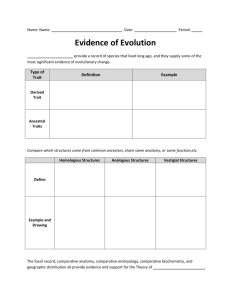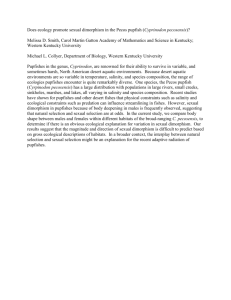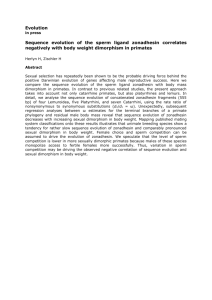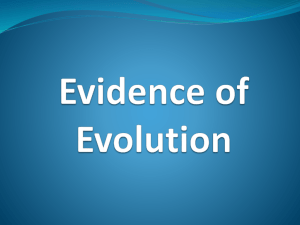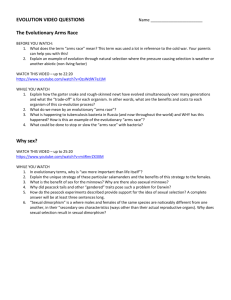funecofigdimo00.doc
advertisement
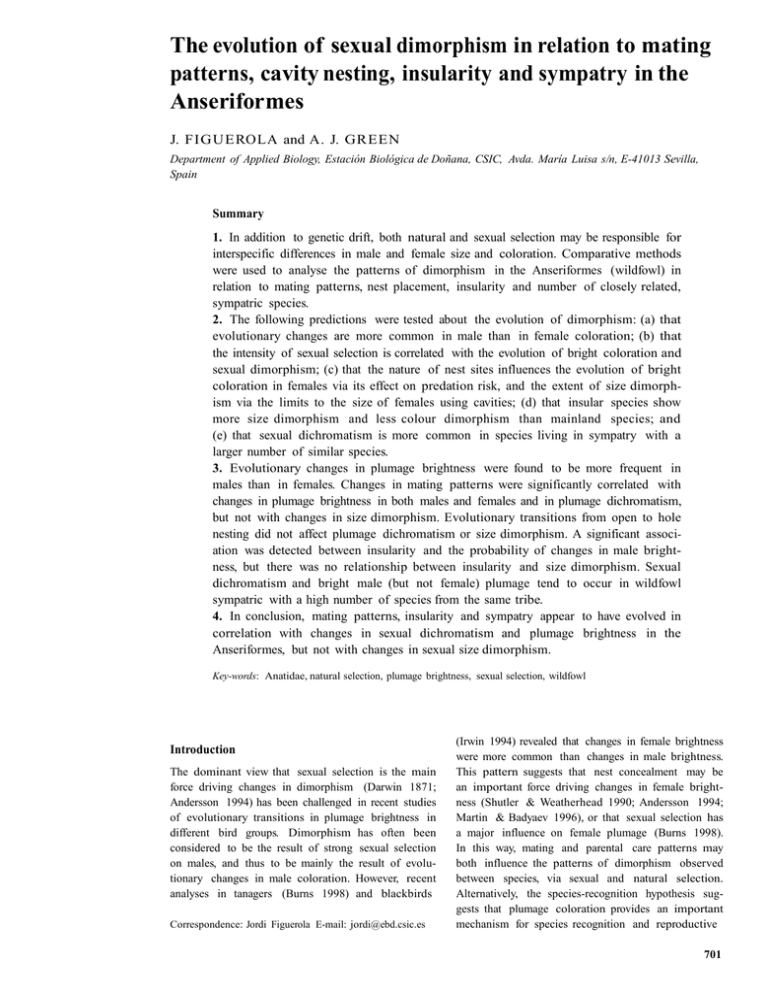
The evolution of sexual dimorphism in relation to mating patterns, cavity nesting, insularity and sympatry in the Anseriformes J. FIGUEROLA and A . J. GREEN Department of Applied Biology, Estación Biológica de Doñana, CSIC, Avda. María Luisa s/n, E-41013 Sevilla, Spain Summary 1. In addition to genetic drift, both natural and sexual selection may be responsible for interspecific differences in male and female size and coloration. Comparative methods were used to analyse the patterns of dimorphism in the Anseriformes (wildfowl) in relation to mating patterns, nest placement, insularity and number of closely related, sympatric species. 2. The following predictions were tested about the evolution of dimorphism: (a) that evolutionary changes are more common in male than in female coloration; (b) that the intensity of sexual selection is correlated with the evolution of bright coloration and sexual dimorphism; (c) that the nature of nest sites influences the evolution of bright coloration in females via its effect on predation risk, and the extent of size dimorphism via the limits to the size of females using cavities; (d) that insular species show more size dimorphism and less colour dimorphism than mainland species; and (e) that sexual dichromatism is more common in species living in sympatry with a larger number of similar species. 3. Evolutionary changes in plumage brightness were found to be more frequent in males than in females. Changes in mating patterns were significantly correlated with changes in plumage brightness in both males and females and in plumage dichromatism, but not with changes in size dimorphism. Evolutionary transitions from open to hole nesting did not affect plumage dichromatism or size dimorphism. A significant association was detected between insularity and the probability of changes in male brightness, but there was no relationship between insularity and size dimorphism. Sexual dichromatism and bright male (but not female) plumage tend to occur in wildfowl sympatric with a high number of species from the same tribe. 4. In conclusion, mating patterns, insularity and sympatry appear to have evolved in correlation with changes in sexual dichromatism and plumage brightness in the Anseriformes, but not with changes in sexual size dimorphism. Key-words: Anatidae, natural selection, plumage brightness, sexual selection, wildfowl Introduction The dominant view that sexual selection is the main force driving changes in dimorphism (Darwin 1871; Andersson 1994) has been challenged in recent studies of evolutionary transitions in plumage brightness in different bird groups. Dimorphism has often been considered to be the result of strong sexual selection on males, and thus to be mainly the result of evolutionary changes in male coloration. However, recent analyses in tanagers (Burns 1998) and blackbirds Correspondence: Jordi Figuerola E-mail: jordi@ebd.csic.es (Irwin 1994) revealed that changes in female brightness were more common than changes in male brightness. This pattern suggests that nest concealment may be an important force driving changes in female brightness (Shutler & Weatherhead 1990; Andersson 1994; Martin & Badyaev 1996), or that sexual selection has a major influence on female plumage (Burns 1998). In this way, mating and parental care patterns may both influence the patterns of dimorphism observed between species, via sexual and natural selection. Alternatively, the species-recognition hypothesis suggests that plumage coloration provides an important mechanism for species recognition and reproductive 701 isolation, and that sympatric species should be more distinctly ornamented than allopatric species (Mayr 1942; Butcher & Rohwer 1989; Price 1998). This hypothesis could explain the duller coloration of birds living on islands in comparison with mainland congeners (reviewed in Butcher & Rohwer 1989), although island populations of some species show brighter plumage than mainland conspecifics (Mayr 1942). Such differences in plumage brightness could also be due to genetic drift through founder effects and/or the small population size of island populations (Mayr 1942; Peterson 1996; Omland 1997). This latter hypothesis predicts that, in a clade with repeated independent colonizations of islands, overall differences between mainland and island species should not have a particular direction, owing to the random nature of genetic drift. However, reduced genetic variation in sexual traits and decreased variation between individuals in small island populations may lower the intensity of sexual selection and thus reduce sexual ornamentation (Petrie & Kempenaers 1998). Direct evidence for the species recognition hypothesis is provided by a relationship between the proportion of dichromatic species in a tribe of passerines and the species diversity of that tribe (Barraclough, Harvey & Nee 1995). Price (1998) expanded these analyses by testing if sexual selection (estimated as the percentage of sexually dichromatic species in each of 20 pairs of passerine tribes) was associated with a high number of species living in sympatry. He failed to find evidence supporting this idea, but the analyses suffered from a series of drawbacks (e.g. sample size, and the large size and different area of the geographic units used), noted by the author. The phylogenetic relationships within Anseriformes are well known for a considerable number of species (Livezey 1997a; Johnson & Sorenson 1999). This group shows great diversity in nesting behaviour and mating patterns, and cavity nesting and insularity have evolved on repeated, independent occasions. Here, using all the living species of ducks, geese and swans (Anseriformes), we present the first study simultaneously to analyse changes in dimorphism and plumage brightness in relation to mating patterns, nest placement and breeding distribution from a phylogenetic perspective. In our analyses, we not only investigate the patterns of association between different variables, we also try to identify which characters evolve first and which follow. Our aim in this article is to test the prediction that mating patterns deviating from monogamy have promoted the evolution of plumage brightness and greater sexual plumage and size dimorphism. We also test the prediction that cavity nesting is associated with an increase in female brightness (owing to a reduction in the risk of being detected by predators during incubation) but has promoted an increase in size dimorphism (by selecting for small female size). Additionally, we test the predictions that insularity has been correlated with a reduction in plumage brightness and an increase in size dimorphism (Weller 1980; Williams, McKinney & Norman 1991), and that sexually dichromatic species live in sympatry with a larger number of related species (Price 1998). This latter relationship could arise by two mechanisms: a role of sexual selection in adaptive radiation producing a higher rate of speciation in clades with mating systems deviating from monogamy, or an increased selection for mechanisms facilitating species recognition in species living in sympatry with more related species. In these analyses, we simultaneously address variation in size and plumage dimorphism in the same group of species (see Hoglund 1989; Owens & Hartley 1998), to test the hypothesis that ecological variables have imposed different selection pressures and constraints on bird size and coloration. Materials and methods The evolution of plumage dimorphism and other ecological variables in the Anseriformes was reconstructed over a working phylogeny based on the morphological analyses of Livezey (1986, 1991, 1995a,b,c, 1996a,b, 1997a,b) and Livezey & Humphrey (1992); see Fig. 1. Data were obtained from various reviews (Cramp & Simmons 1977; Johnsgard 1978; Bellrose 1980; Brown, Urban & Newman 1982; Scott & CluttonBrock 1989; Marchant & Higgins 1991; Johnsgard & Carbonell 1996; Oxford University Press, unpublished data), and the complete data set is available from the authors on request. Mean male and female body mass were recorded only when derived from at least five individuals of each sex. Male and female plumage brightness was scored following Scott & Clutton-Brock (1989). Like them, we considered drab plumages to include those that were dull brown or grey, and also those with small patches of brighter colour. Unlike them, we also scored as drab those species with coloured plumage that probably did not contrast against their habitat (following Butcher & Rohwer 1989). A species was considered dichromatic when there were differences in colour great enough to allow the identification of the sexes in the field. For species not included in Scott & Clutton-Brock (1989), scoring was done using the colour plates of Madge & Burn (1988). To estimate the number of evolutionary changes in plumage brightness and colour dimorphism we used a modified version of Burns’ (1998) categories to score each species as one of the following: (1) monomorphic with both sexes drab; (2) monomorphic with both sexes bright; (3) dimorphic, male colourful and female drab; (4) dimorphic with both sexes drab; (5) dimorphic with both sexes colourful; (6) dimorphic with male drab and female colourful. The minimum, maximum and mean number of changes occurring in dichromatism and plumage brightness were estimated using parsimony algorithms with the program (Maddison & Maddison 1992). Species were classified as open or cavity nesters according to 703 Sexual dimorphism in Anseriformes © Fig. 1. Phylogeny for the Anseriformes used in this study, based on the morphological analyses of Livezey (1986, 1991, 1995a,b,c, 1996a,b, 1997a,b) and Livezey & Humphrey (1992). The characters in some parts of the tree could not be resolved by parsimony algorithms and are reported as equivocal. This is why the number of unambiguous changes and mean number of changes are reported in Table 1. descriptions in the above revisions. Frequency of pair formation was used as an estimate of intensity of sexual selection, considering the two categories defined by Scott & Clutton-Brock (1989): species that pair less than once per season, and species that pair on one or more occasions per season. Insular species were defined as those endemic to small islands with an area of less than 20 000 km2 (after Green 1996). The number of species living in sympatry was estimated by plotting the breeding distribution maps in Madge & Burn (1988) over a grid, a projection of the world divided into 611 000-km2 grid squares (Gaston & Blackburn 1996; Williams 1996). The total number of species of the same tribe breeding in the squares occupied by the species was used as an index of sympatry. This index is likely to overestimate the number of species living in sympatry because some of them could breed in different habitats with no real possibility of interaction during the breeding season. Another potential problem associated with this index is that a variable proportion of the individuals of some Anseriformes pair in winter (Baldassarre & Bolen 1994), when the species could be in sympatry with different species than during the breeding season. Consequently, our sympatry index is an imperfect measure of the real number of potential competitors living in sympatry. The associations between the evolution of mating systems or nest placement and plumage brightness and dichromatism were analysed separately following Pagel (1994). This method is based on a Markovtransition rate model of trait evolution, and since the results do not depend on the particular set of ancestral values that might be assigned by parsimony, the problems derived from ancestral character reconstruction are avoided (Pagel 1997). However, the model assumes a constant probability of change throughout the tree. A model of independent evolution and another of correlated evolution were calculated and the model best fitting the data was identified by maximum likelihood statistical methods, using the program (Pagel 1997, 1999). To ensure that the most stable solution was reached, analyses were repeated until four estimates of model likelihood were obtained that differed only at the second or lower decimal place. The statistical significance of differences between the evolution-dependent and independent models was determined using Monte Carlo tests, because the statistic does not match any commonly used statistical distribution. The likelihood ratio (LR) obtained from the data was compared to those derived from 200 runs simulating the evolution of the two characters studied over the phylogeny using the independent model parameters. Each of these simulations was analysed with the models of dependent and independent changes, and the LR was calculated. The directionality of the significant relationships was tested according to Pagel (1994), by forcing the relevant parameter in the model of dependent evolution to take the same value as another related parameter in the model. For example, to determine whether shorter pair bonds are associated with increased frequency of evolution of sexual dichromatism, the probabilities of change in dichromatism in species with short and long pair bonds were forced to take the same value. If this model had a significantly reduced fit to the data, the hypothesis of equal probability of change with respect to mating frequency was rejected. In these analyses, the statistical significance of the changes in likelihood was determined using the χ2 distribution (1 df ). Pagel’s method cannot deal with polytomies (multiple speciation events or unresolved parts of the tree, see Fig. 1), and for these analyses a fully resolved parsimonious version of the tree was used (i.e. that tree minimizing the number of evolutionary changes in the characters of interest). In most cases, interspecific data should not be analysed with traditional regression methods, because data from different species are not statistically independent. Thus, to examine the relation between size and different ecological variables, independent contrasts were used (Felsenstein 1985; Harvey & Pagel 1991). The contrasts were calculated as the differences in the characters of interest between pairs of closely related taxa. These contrasts were standardized in relation to the time elapsed since the separation of the lineages in the tree, by using estimated branch lengths. Although the original data are not independent between taxa, under a Brownian motion model of evolution, each contrast is independent of other contrasts calculated over the tree (Harvey & Pagel 1991). To calculate size dimorphism in body mass, the independent contrasts of male mass were regressed on the contrasts of female mass. The slope of the regression through the origin was used to calculate the residuals for each species (Purvis & Rambaut 1995a). The relationships between mating system or nesting behaviour and male mass, female mass and size dimorphism were analysed separately using the brunch procedure in the program. This method is particularly appropriate if the main predictor is a categorical variable, when most of the statistical assumptions are violated if the data are analysed with normal independent contrasts analysis (Harvey & Pagel 1991). With the brunch method, a reduced number of contrasts are calculated because of the way species data are used in this procedure (Purvis & Rambaut 1995b). Since no detailed information was available to estimate branch length for the whole Anseriformes phylogeny, unity branch lengths were used in all the analyses (Purvis, Gittleman & Luh 1994). Independent comparisons were used to analyse the relationship between sexual dichromatism and the number of sympatric species. The evolution of sexual dichromatism was reconstructed using the program. Based on this reconstruction (Fig. 1), we chose pairs of species formed by one species with and another without sexual dichromatism, with the only constraint being that both should pertain to the same tribe (in order to allow comparison of the sympatry index). Only one pair of species was constructed for each independent change in sexual dichromatism. The size of breeding ranges and the number of sympatric species were compared using paired t-tests (t) or Wilcoxon matched pairs signed rank tests (W) where data were not normally distributed. To investigate the relationship between the differences in number of sympatric species and size dimorphism, the same pairs of species were rearranged into two groups, containing the more size dimorphic (with larger males in relation to female size) and less dimorphic species of each pair, respectively. Mean values ± SD are presented throughout the paper. To determine the extent to which our results were dependent on the phylogeny used, all the above analyses were repeated incorporating an alternative phylogeny for the tribe Anatini, based on molecular data (Johnson & Sorenson 1999). Since the results of this second set of analyses did not differ from analyses performed with the morphologically based Livezey phylogeny, only results for the latter phylogeny are reported below, owing to the higher number of species included in this phylogeny. Additionally, all the analyses using traditional non-phylogenetic methods were repeated using species raw data. The results of these analyses have been discussed only when differing significantly from phylogenetic analyses. Details of these other analyses are available from the authors. Our analyses are subjected to the biases resulting from a large number of extinctions of wildfowl species caused by human activities (Green 1996; Young, Tonge & Hume 1997). Most of these were insular Table 1. Evolutionary changes in plumage dimorphism (following Burns 1998 – see Methods for definitions of the categories 1– 6) in the Anseriformes. Reconstruction was based on a phylogenetic tree with polytomies resolved so as to minimize changes in plumage dimorphism. Mean number of changes estimated from equally parsimonious reconstructions of character evolution, the number of unambiguous changes (changes occurring in all the equally parsimonious reconstructions) and range (in parentheses) are presented in that order (see Fig. 1) Change in female, but not in male plumage (change affects dichromatism) Change in male, but not in female plumage (change affects dichromatism) Change in male, but not in female plumage (change does not affect dichromatism) Changes in both sexes © 2000 British Ecological No change Society, in either sex Functional Ecology, 14, 701– 710 1–6 6–1 2–3 3–2 1–3 3–1 2–6 6–2 3–4 4–3 5–6 6–5 1–2 1–5 2–1 4–2 1–4 4–1 2·17 0·50 0·25 1·99 5·58 1·98 0·17 0·17 4·60 7·99 0·17 0·67 8·58 0·33 2 0·26 9·65 2·94 1 (1–3) 0 (0–1) 0 (0–1) 1 (1–3) 2 (2–9) 1 (1–3) 0 (0–1) 0 (0–1) 0 (1–9) 5 (5–13) 0 (0–1) 0 (0–1) 5 (6–10) 0 (0–1) 1 (1–3) 0 (0–1) 2 (3–13) 1 (1–10) species with unknown degrees of sexual dimorphism. Likewise, anthropogenic factors have doubtless led to range modifications in many extant species, affecting our measures of sympatry. Results Evolutionary changes in size dimorphism in the Anseriformes were unrelated to changes in plumage dimorphism (mean contrast = –7·31 ± 60·80, n = 20, W = –12·00, P = 0·67). The reconstruction of changes in plumage dimorphism suggested that at least 50 evolutionary changes have occurred in the clade studied. Changes confined to male coloration were more frequent than changes confined to female coloration (mean number of changes, χ 2 = 10·28, 1 df, P = 0·001; unambiguous changes, χ 2 = 3·60, 1 df, P = 0·05; Table 1). The evolution of sexual dichromatism in the Anseriformes was correlated with the evolution of mating systems deviating from monogamy (LR = 28·74, P < 0·005). Changes to long-term monogamous mating systems were more frequent in monochromatic species ( χ 2 = 5·03, 1 df, P = 0·03). Changes in male brightness (LR = 9·88, P = 0·05) and female brightness (LR = 14·52, P = 0·01) were correlated with changes in mating system. In the case of males, the acquisition of bright plumage was more likely in species with mating systems deviating from long-term monogamy ( χ 2 = 5·12, 1 df, P = 0·03). In females, there was a non-significant trend for transitions to drab plumage to be associated with long-term monogamous mating systems ( χ 2 = 3·17, 1 df, P = 0·08). There was no association between the evolution of sexual dichromatism and nesting strategy (LR = 5·35, P = 0·34). No significant relationship was detected between the evolution of male or female coloration and nesting strategy (males: LR = 6·37, P = 0·21; females: LR = 2·52, P = 0·72). No association was detected between evolutionary changes in sexual dichromatism and insularity (LR = 4·22, P = 0·31). An association was detected between evolutionary changes (reductions) in male brightness and insularity (LR= 10·64, P = 0·01) but this was not the case for females (LR = 5·94, P = 0·17). However, correlated evolution of male plumage and insularity did not translate into a particular dependence of Table 2. Pairs of species used in comparisons of number of sympatric species and breeding range (estimated as the number of 611·000-km2 grid squares occupied wholly or partially during the breeding season) according to (a) sexual dichromatism, (b) male plumage brightness and (c) female plumage brightness Species Breeding range Sympatry Species Breeding range (a) Dichromatic species Tadorna tadornoides Chloephaga picta Tachyeres brachypterus Aix sponsa Anas laysanensis Anas platyrhynchos Anas clypeata Anas acuta Anas chlorotis Anas formosa Anas penelope Anas strepera Aythya valisineria Mergus cucullatus Oxyura jamaicensis 7 7 1 15 1 107 70 84 5 6 38 53 9 19 50 0 3 2 0 1 16 15 14 3 8 9 14 4 11 3 Monochromatic species Tadorna radjah Chloephaga poliocephala Tachyeres ptenere Cairina moschata Anas wyvilliana Anas fulvigula Anas rubripes Anas georgica Anas gibberifrons Anas versicolor Anas sibilatrix Anas capensis Aythya australis Mergus australis Biziura lobata 11 5 4 36 1 3 15 17 33 16 8 23 8 1 8 0 3 2 3 1 1 7 8 6 9 7 5 0 0 1 (b) Bright males Anser indicus Branta leucopsis Cygnus melanocoryphus Tadorna tadornoides Chloephaga picta Aix sponsa Anas platyrhynchos Anas clypeata Anas acuta Anas formosa Anas penelope Anas strepera Netta peposaca Aythya collaris Aythya valisineria Mergus cucullatus Melanitta perspicillata Histrionicus histrionicus Oxyura leucocephala Oxyura jamaicensis 7 3 8 7 7 15 107 70 84 6 38 53 5 16 9 19 20 38 16 50 5 8 1 0 3 0 16 15 14 8 9 14 0 4 4 11 14 15 0 3 Drab males Anser canagicus Branta ruficollis Cygnus atratus Tadorna variegata Chloephaga poliocephala Cairina moschata Anas fulvigula Anas smithii Anas discors Anas crecca Anas americana Anas falcata Netta erythroftalma Aythya novaesellandiae Aythya baeri Mergus australis Melanitta fusca Melanitta nigra Oxyura maccoa Oxyura vittata 2 4 22 4 5 36 3 4 19 59 22 15 16 4 5 1 51 31 18 9 5 7 0 0 3 3 1 5 8 10 8 9 0 0 2 0 16 14 0 3 (c) Bright females Anser indicus Branta leucopsis Cygnus melanocoryphus Tadorna tadornoides Chloephaga melanoptera Cairina scutulata Anas bahamensis Anas sibilatrix Mergus octosetaceus 7 3 8 7 7 3 15 8 2 5 8 1 0 1 2 6 7 0 Drab females Anser canagicus Branta ruficollis Cygnus atratus Tadorna ferruginea Chloephaga poliocephala Pteronetta hartlaubi Anas erythorhyncha Anas capensis Mergus cucullatus 2 4 22 34 5 10 23 23 78 5 7 0 3 3 3 7 5 11 changes in one character on the state of the other (χ2 < 2·07, P > 0·16 for all the contrasts). In other words, there is no evidence that the evolution of insularity has systematically preceded a reduction in plumage brightness, or vice versa. The relationship between male brightness and insularity was not explained by an association between insularity and changes in mating system, as no such association was observed (LR = 2·86, P = 0·66). Sympatry A total of 15 pairs of species formed by one dichromatic and one monochromatic species were constructed (see Table 2). Dichromatic species live in sympatry with a higher number of species from the same tribe than monochromatic species (dichromatic species 707 Sexual dimorphism in Anseriformes Table 3. Analyses of the associations between changes in mating system (n = 14), nesting strategy (n = 17 for females, n = 16 for others) and insularity (n = 5) and independent contrasts in male body mass, female mass and sexual dimorphism in mass. The null hypothesis of no association (i.e. that the mean values of the independent contrasts do not differ from zero) was tested with a Wilcoxon signed-ranks test. See methods for details of how these contrasts were calculated Mating system Mean contrast Male 32·85 Female 13·09 Dimorphism 5·65 SD Nesting strategy W P Mean contrast 279·74 –1·50 0·95 –270·48 261·59 –9·50 0·58 –195·84 68·21 0·50 1·00 7·23 6·87 ± 5·85, monochromatic species 3·53 ± 3·18, t14 = 2·41, P = 0·03). This was probably explained by a trend for dichromatic species to have a larger breeding range (dichromatic species 31·47 ± 33·95, monochromatic species 12·60 ± 10·91, t14 = 2·04, P = 0·06), because no differences occurred between dichromatic and monochromatic species in the species in sympatry/ breeding range ratio (dichromatic species 1·17 ± 2·77, monochromatic species 0·36 ± 0·32, n = 15, Wilcoxon sign test = 14·50, P = 0·39). When testing for differences between species with drab and bright plumage separately for each sex, species with bright males lived in sympatry with more species than those with drab males (bright 7·20 ± 5·91, drab 4·70 ± 4·87, n = 20, W = 32·50, P = 0·04, Table 2), although again no differences were detected when analysing the sympatric species/breeding range ratio (bright 0·44 ± 0·62, drab 0·48 ± 0·65, n = 20, W = 8·50, P = 0·71). There was no significant relationship between female plumage and number of species living in sympatry (bright 3·33 ± 3·16, drab 4·89 ± 3·18, n = 9, W = 7·50, P = 0·38). , , Niether male body mass, female mass nor size dimorphism was associated with evolutionary changes in mating system, nest placement or insularity in the Anseriformes (Table 3). No differences in the number of sympatric species were found between more and less size dimorphic species (5·95 ± 4·99 vs 6·00 ± 6·08 species, n = 19, W = 4·50, P = 0·77). Discussion © 2000 British Ecological Society, Functional Ecology, 14, 701– 710 The use of character reconstruction to infer evolutionary processes has been extensively debated. Obviously, the quality of the results depends on the reliability of the phylogeny used (Martins 1996) and the applicability of the statistical model (Price 1997). In our case we have used a morphological phylogeny for the Anseriformes that has a high congruence with molecular phylogenies constructed for nine American Insularity SD W P Mean contrast 657·14 –21·00 0·30 –265·74 467·62 –14·50 0·52 –211·29 165·66 18·00 0·38 10·62 SD W P 411·53 –5·50 0·19 337·26 –5·50 0·19 64·68 2·50 0·63 species (Omland 1994), or for most species in the genus Anas (Johnson & Sorenson 1999). Analyses of character associations usually rely on the reconstruction of an ancestral state and the changes occurring through the phylogeny (Maddison 1995). This kind of analysis assumes an equal probability of gaining or losing a character (or any other fixed relation between the probability of gaining or losing a character). The violation of this assumption could severely bias the analyses, as Omland (1997) has demonstrated in the case of sexual dichromatism in Anseriformes. However, most of the methods used in the present study do not rely upon the reconstruction of ancestral states nor on assumptions about the relative probability of change (Pagel 1994), so the results of these analyses are not exposed to the problems raised by Omland (1997). Sexual dimorphism in size and/or coloration is a widespread phenomenon (Price & Birch 1996; Fairbairn 1997). In the case of Anseriformes, the two forms of dimorphism are unrelated from a phylogenetic perspective, suggesting that they are subjected to different selection pressures. Thus, we found that neither mating system, nesting strategy nor insularity explained variance in sexual size dimorphism in wildfowl. Likewise, the number of species living in sympatry was not associated with variation in size dimorphism. In contrast, Sigurjónsdóttir (1981) reported a positive relationship between nest concealment and size dimorphism in this group. She used four categories of nest concealment and analysed them as a continuous variable: nest on bare ground; nest in long grass or reed beds; the latter strategy but also nesting occasionally in cavities; and nesting in cavities. Sigurjónsdóttir considered that her significant result was due to species breeding in cavities. However, this result was only significant for one subfamily (Anatinae), the effects of phylogeny were not controlled for satisfactorily, and the effect of nesting in cavities was not separated from the effects of other nesting habitats. When we repeated our analyses without controlling for phylogeny, a significant effect of cavity nesting on male and female size and size dimorphism was detected. However, cavity nesting is a character with a high phylogenetic load (45 species nest in cavities, but the 708 J. Figuerola & A. J. Green © 2000 British Ecological Society, Functional Ecology, 14, 701– 710 character has evolved independently on only seven occasions), and we therefore suggest these results are an artefact due to not controlling for phylogenetic relationships. The same patterns occur when we analysed size dimorphism in relation to mating system without controlling for phylogeny: males and females were larger in species with long-term monogamy. However, phylogeny again explains an important fraction of the variation in mating frequency (73 species show short-term monogamy, but they derive from only seven transitions from long-term to shortterm monogamy), and these results are probably an artefact of the inclusion of true geese and swans, all of which are characterized by large size and long-term monogamy. Insularity has previously been reported to decrease body size and increase sexual size dimorphism in some Anas lineages but not consistently across the Anseriformes (Weller 1980; Livezey 1990, 1993; Williams et al. 1991). Our analyses did not find any significant relationship between insularity and changes in size, although they were based on a small number of independent changes in insularity. In contrast to our results for size dimorphism, we found several factors that explain the variation in plumage coloration in the Anseriformes. Changes in plumage dimorphism are largely due to changes in male brightness in this family. Although this pattern supports sexual selection theory, previous analyses published for other birds have failed to support this prediction, and have reported a higher variability in female plumage (Irwin 1994; Burns 1998). Anseriform species mating at least once per season were more sexually dichromatic than those species maintaining pair bonds for more than a year. Our results support Scott & Clutton-Brock (1989) who reported an association between mating patterns and male brightness and sexual dichromatism, without controlling for phylogeny. We have expanded their work by incorporating phylogeny in the analyses, by examining the order of change of the different characters analysed, and by considering plumage brightness in the context of the habitat used by the species. Furthermore, we found for the first time that changes in female brightness were also related to changes in mating system, as could be expected from studies demonstrating selection for female ornaments (Johnson 1988; Hill 1993; Jones & Hunter 1993), and a higher rate of evolutionary changes in female than in male coloration (Irwin 1994; Burns 1998). In wildfowl, drab female plumage is mainly associated with long-term monogamy, and bright plumage with short-term monogamy. This pattern could potentially be explained by a genetic correlation between male and female plumage (Lande & Arnold 1985). However, the dominance of evolutionary changes in coloration in only one sex and not in both sexes (26·24 vs 10·17 mean changes, χ 2 = 7·09, 1 df, P = 0·007), and the different patterns of covariation of male and female brightness with the different ecological variables considered in the present study are not compatible with this explanation. Alternatively, an increase in intrasexual competition between females and/or a degree of male choice in species with short-term pair bonds could have caused the observed increases in female ornamentation. In finches and Parulidae, female (but not male) brightness was related positively with nest height within vegetation and negatively with risk of nest predation (Martin & Badyaev 1996). In the case of the Anseriformes, sexual dichromatism and male and female brightness were not related to changes in nest placement. The relationships we have found between sympatry, insularity and plumage brightness support the ‘species recognition hypothesis’. Our analyses confirm previous suggestions that insularity is associated with changes in plumage brightness in the Anseriformes. The reduced male brightness observed in the seven island species was considered to be the result of sympatry with a reduced number of congeneric species (Mayr 1942). This hypothesis is also supported for all the wildfowl by our analyses of the number of species living in sympatry. However, this may not be the only explanation for reduced brightness in insular species, because many selective pressures can differ on islands. Insularity may have favoured the evolution of more stable pair bonds and long-term monogamy, and this might explain the changes in sexual dimorphism (Selander 1965; for the Anatidae, see also Weller 1980). Data are poor for many insular species but, although a shift to long-term pair bonds is apparent in some insular Anas, this trend is not apparent in other insular species (Livezey 1989, 1990, 1993). Furthermore, we have shown that, for the Anseriformes as a whole, there is no significant association between pair-bond duration and insularity. Alternatively, genetic drift and inbreeding in small island populations can lead to low levels of genetic variation that could decrease among-individual variance, lower the intensity of sexual selection and so reduce sexual ornamentation (Peterson 1996; Petrie & Kempenaers 1998). In conclusion, mating patterns, insularity and the number of potential sympatric species are associated with changes in plumage coloration (but not body size) in Anseriformes. Changes in the coloration of males are particularly frequent in this group, associated especially with these three ecological variables. However, increases in female brightness are also related to increases in mating frequency, even in this predominantly monogamous group. These results support the view that both sexual selection and species recognition are important forces driving the evolution of sexual dichromatism. Acknowledgements We are grateful to G. Callard, J. Kear, K. Kilpatrick, A. Marshall, H. G. Young and Oxford University 709 Sexual dimorphism in Anseriformes Press for their help in compiling the data on which our analyses are based. K. P. Johnson and B. C. Livezey provided helpful correspondence. D. Callaghan and two anonymous referees provided helpful comments on earlier versions of the manuscript. References © 2000 British Ecological Society, Functional Ecology, 14, 701– 710 Andersson, M. (1994) Sexual Selection. Princeton University Press, Princeton, NJ. Baldassarre, G.A. & Bolen, E.G. (1994) Waterfowl Ecology and Management. John Wiley & Sons, New York. Barraclough, T.G., Harvey, P.H. & Nee, S. (1995) Sexual selection and taxonomic diversity in passerine birds. Proceedings of the Royal Society of London B 259, 211–215. Bellrose, F.C. (1980) Ducks, Geese and Swans of North America. Stackpole Books, Harrisburg, PA. Brown, L.H., Urban, E.K. & Newman, K. (1982) The Birds of Africa, Vol. 1. Academic Press, London. Burns, K.J. (1998) A phylogenetic perspective on the evolution of sexual dichromatism in Tanagers (Thraupidae): the role of female versus male plumage. Evolution 52, 1219– 1224. Butcher, G.S. & Rohwer, S. (1989) The evolution of conspicuous and distinctive coloration for communication in birds. Current Ornithology 6, 51–107. Cramp, S. & Simmons, K.E.L. (1977) The Birds of the Western Parlearctic, Vol. 1. Oxford University Press, Oxford. Darwin, C. (1871) The Descent of Man, and Selection in Relation to Sex. Murray, London. Fairbairn, D.J. (1997) Allometry for sexual size dimorphism: Pattern and process in the coevolution of body size in males and females. Annual Review of Ecology and Systematics 28, 659–687. Felsenstein, J. (1985) Phylogenies and the comparative method. American Naturalist 125, 1–15. Gaston, K.J. & Blackburn, T.H. (1996) Global macroecology: interactions beween population size, geographic range size and body size in the Anseriformes. Journal of Animal Ecology 65, 701–714. Green, A.J. (1996) Analyses of globally threatened Anatidae in relation to threats, distribution, migration patterns and habitat use. Conservation Biology 10, 1435 –1445. Harvey, P.H. & Pagel, M.D. (1991) The Comparative Method in Evolutionary Biology. Oxford University Press, Oxford. Hill, G.E. (1993) Male mate choice and the evolution of female coloration in the house finch. Evolution 47, 1515– 1525. Hoglund, J. (1989) Size and plumage dimorphism in lek-breeding birds: a comparative analysis. American Naturalist 134, 72–87. Irwin, R.E. (1994) The evolution of plumage dichromatism in the New World blackbirds: social selection on female brightness? American Naturalist 144, 890 –907. Johnsgard, P.A. (1978) Ducks, Geese and Swans of the World. University of Nebraska, Lincoln, Nebraska. Johnsgard, P.A. & Carbonell, M. (1996) Ruddy Ducks and Other Stifftails. University of Oklahoma Press, Norman, OK. Johnson, K. (1988) Sexual selection in pinyon jays. II. Male choice and female–female competition. Animal Behaviour 36, 1048–1053. Johnson, K.P. & Sorenson, M.D. (1999) Phylogeny and biogeography of the dabbling ducks (Genus: Anas): a comparison of molecular and morphological evidence. Auk 116, 792–805. Jones, I.L. & Hunter, F.M. (1993) Mutual sexual selection in a monogamous seabird. Nature 362, 238–239. Lande, R. & Arnold, S.J. (1985) Evolution of mating preference and sexual dimorphism. Journal of Theoretical Biology 117, 651– 664. Livezey, B.C. (1986) A phylogenetic analysis of recent anseriform genera using morphological characters. Auk 103, 737–754. Livezey, B.C. (1989) Phylogenetic relationships and incipient flightlessness of the extinct Auckland Islands merganser. Wilson Bulletin 101, 410 – 435. Livezey, B.C. (1990) Evolutionary morphology of flightlessness in the Auckland Islands teal. Condor 92, 639– 673. Livezey, B.C. (1991) A phylogenetic analysis and classification of recent dabbling ducks (Tribe Anatini) based on comparative morphology. Auk 108, 471–508. Livezey, B.C. (1993) Comparative morphometrics of Anas ducks, with particular reference to the Hawaiian duck Anas wyvilliana, Laysan Duck A. laysanensis, and Eaton’s Pintail A. eatoni. Wildfowl 44, 75–100. Livezey, B.C. (1995a) Phylogeny and comparative ecology of stiff-tailed ducks (Anatidae: Oxyurini). Wilson Bulletin 107, 214–234. Livezey, B.C. (1995b) Phylogeny and evolutionary ecology of modern seaducks (Anatidae: Mergini). Condor 97, 233–255. Livezey, B.C. (1995c) A phylogenetic analysis of the whistling and white-backed ducks (Anatidae: Dendrocygninae) using morphological characters. Annals of Carnegie Museum 64, 65–97. Livezey, B.C. (1996a) A phylogenetic analysis of geese and swans (Anseriformes: anserinae), including selected fossil species. Systematic Zoology 45, 415– 450. Livezey, B.C. (1996b) A phylogenetic analysis of modern pochards (Anatidae: aythyini). Auk 113, 74 –93. Livezey, B.C. (1997a) A phylogenetic classification of waterfowl (Aves: anseriformes), including selected fossil species. Annals of Carnegie Museum 66, 457– 496. Livezey, B.C. (1997b) A phylogenetic analysis of modern sheldgeese and shelducks (Anatidae, Tadornini). Ibis 139, 51– 66. Livezey, B.C. & Humphrey, P.S. (1992) Taxonomy and identification of steamer-ducks (Anatidae: Tachyeres). University of Kansas, Museum of Natural History Monographs 8, 1–125. Maddison, W.P. (1995) Calculating the probability distributions of ancestral states reconstructed by parsimony on phylogenetic trees. Systematic Zoology 44, 474 – 481. Maddison, W.P. & Maddison, D.R. (1992) Macclade: Analysis of Phylogeny and Character Evolution, Version 3.0. Sinauer, Sunderland, MA. Madge, S. & Burn, H. (1988) Wildfowl: an Identification Guide to the Ducks, Geese and Swans of the World. Helm, London. Marchant, S. & Higgins, P.J. (1991) Handbook of Australian, New Zealand and Antarctic Birds, Vol. 1. Oxford University Press, Oxford. Martin, T.E. & Badyaev, A.V. (1996) Sexual dichromatism in birds: importance of nest predation and nest location for females versus males. Evolution 50, 2454 –2460. Martins, E.P. (1996) Phylogenies, spatial autoregression, and the comparative method: a computer simulation test. Evolution 50, 1750 –1765. Mayr, E. (1942) Systematics and the Origin of Species. Columbia University Press, New York. Omland, K.E. (1994) Character congruence between a molecular and a morphological phylogeny for dabbling ducks (Anas). Systematic Biology 43, 369–386. Omland, K.E. (1997) Examining two standard assumptions of ancestral reconstructions: repeated loss of dichromatism in dabbling ducks (Anatini). Evolution 51, 1636 –1646. Owens, I.P.F. & Hartley, I.R. (1998) Sexual dimorphism in birds: why are there so many different forms of dimorphism? Proceedings of the Royal Society of London B 265, 397– 407. 710 J. Figuerola & A. J. Green © 2000 British Ecological Society, Functional Ecology, 14, 701– 710 Pagel, M. (1994) Detecting correlated evolution on phylogenies: a general method for the comparative analysis of discrete characters. Proceedings of the Royal Society of London B 255, 37– 45. Pagel, M. (1997) Inferring evolutionary processes from phylogenies. Zoologica Scripta 26, 331–348. Pagel, M. (1999) The maximum likelihood approach to reconstructing ancestral character states of discrete characters on phylogenies. Systematic Biology 48, 612– 622. Peterson, A.T. (1996) Geographic variation in sexual dichromatism in birds. Bulletin of the British Ornithologist Club 116, 156–172. Petrie, M. & Kempenaers, B. (1998) Extra-pair paternity in birds: explaining variation between species and populations. Trends in Ecology and Evolution 13, 52–58. Price, T. (1997) Correlated evolution and independent contrasts. Philosophical Transactions of the Royal Society 352, 519 – 529. Price, T. (1998) Sexual selection and natural selection in bird speciation. Philosophical Transactions of the Royal Society of London B 353, 251–260. Price, T. & Birch, G.L. (1996) Repeated evolution of sexual color dimorphism in passerine birds. Auk 113, 842– 848. Purvis, A., Gittleman, J.L. & Luh, H.-K. (1994) Truth or consequences: effects of phylogenetic accuracy on two comparative methods. Journal of Theoretical Biology 167, 293 –300. Purvis, A. & Rambaut, A. (1995a) Comparative analysis by independent contrasts (CAIC). A statistical package for the Apple Macintosh, Version 2.0. http:// evolve.zps.ox.ac.uk/CAIC/CAIC.html. Purvis, A. & Rambaut, A. (1995b) Comparative analysis by independent contrasts (CAIC): an Apple Macintosh application for analysing comparative data. Computer Applied Biosciences 11, 247–251. Scott, D.K. & Clutton-Brock, T.H. (1989) Mating systems, parasites and plumage dimorphism in waterfowl. Behavioural Ecology and Sociobiology 26, 261–273. Selander, R.K. (1965) On mating systems and sexual selection. American Naturalist 99, 129–141. Shutler, D. & Weatherhead, P.J. (1990) Targets of sexual selection: song and plumage of wood warblers. Evolution 44, 1967–1977. Sigurjónsdóttir, H. (1981) The evolution of sexual size dimorphism in gamebirds, waterfowl and raptors. Ornis Scandinavica 12, 249–260. Weller, M.W. (1980) The Island Waterfowl. Iowa State University Press, Ames, IA. Williams, M., McKinney, F. & Norman, F.I. (1991) Ecological and behavioural responses of austral teal to island life. Acta XX Congressus Internationalis Ornithologici 2, 876 – 884. Williams, P. (1996) WORLDMAP, Priority Areas for Biodiversity: Using Version 4. (Privately distributed computer software and manual), London. Young, H.G., Tonge, S.J. & Hume, J.P. (1997) Review of Holocene wildfowl extinctions. Wildfowl 47, 166 –180. Received 22 December 2000; revised 26 April 2000; accepted 3 May 2000
